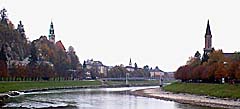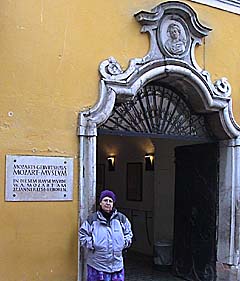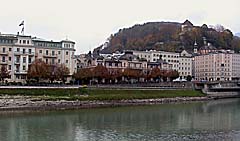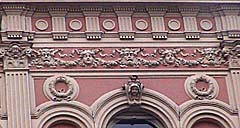
Week 6, part 2
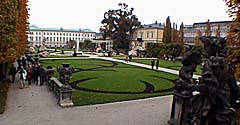 Local walkers and visiting tourists stroll through the grand sculpture garden and park in central Salzburg.
A view of the Salzburg Riverfront from the footbridge.
RoZ stands in front of the doorway to Mozart's birthplace.
|
Most people come to Salzburg because of Mozart ... his birthplace and his residence attract many pilgrims, and RoZ felt the need to make the pilgrimage. It was a fairly short walk to central Salzburg, and the stark, plain high-rise apartment complexes quickly gave way to elegant works of 18th-century architecture. It was noon when we found ourselves in a park about the size of a football field that was filled with magnificent sculptures, and where flowers were planted in arrangements that formed flowing artistic patterns on the grass. To the sounds of noon-time bells simultaneously ringing all over the city, we enjoyed the park alongside the Salzburg suits and a group of Japanese tourists. After saying hello to Mozart's house, we crossed a footbridge to the "old" part of the city (In this part of the world, anything less than 300 years old is "new."). A wall of stylish old buildings faced the river. Several passages led through this row into a series of courtyards and small plazas that opened up onto a narrow cobblestone street called Getreidegasse. Getreidegasse was overrun with shoppers, tourists, and other pilgrims seeking out the Mozart birthplace, which we found right where the map said it would be. Along the way our lenses were filled with architectural eye candy, and the narrow streets were lined with shops selling everything from fine artwork and musical instruments to McScheisse. According to our map, we saw but a corner of a vast pedestrianized area of old Salzburg; and we're sure the rest of this area was filled with many wonderful things to see and explore. But we had lost a great deal of time in Munich, and we were quickly using up the few hours we had devoted to Salzburg. We made our way to the other side of the river, and gradually meandered toward our penzion grabbing bread, cheese, and chocolate along the way. Mozart was a prima donna, and Salzburg seems to be a city filled with prima donnas. We were disturbed by the condescending treatment we received from many shopkeepers, even as we were handing them our money. We can remember one or two who were nice (especially our penzion hosts, and the young guy who sold us cheese), but most of the locals seemed to treat us like pond scum. Central Salzburg seems to be a place for the black-suited art snobs who look down their noses at anyone who does not look like one of them. Come to central Salzburg to take pictures, but stay and spend your money in the more working-class fringes. The people in the central city have plenty of money and don't seem to deserve it. We grabbed our packs and got to the Bahnhof just in time for the 2:00 train for Vienna. As we rode across the Austrian countryside, we wondered what we'd accomplish by arriving in Vienna after dark. Other than to take pictures of pretty buildings, we couldn't think of a compelling reason to go there, and our treatment in Salzburg left us wanting to skip Vienna and to go directly to Prague. Having a rail pass gives us the luxury of changing our minds while we're still on the train, so rather than go to Vienna we got off the train in Linz and connected to a train headed for the town of Summerau on the Czech border.
|
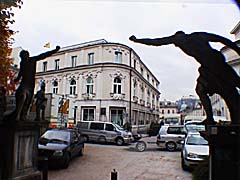 Parking trucks and minivans clutter the view of the park entrance.
In the upper photo, the pink building on the riverfront is an ornately-decorated bank. The lower photo concentrates on some of the detail over the front entrance to what we now only know of as "The Pink Bank."
|
More photos from Salzburg
Next page
week 6 index
purplearth 2001 europe oddyzee index
purplearth home
